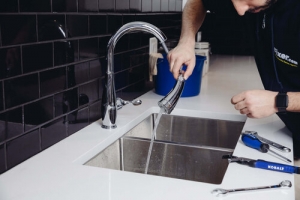Everybody may have their own individual thinking in relation to Should I Repair or Replace a Leaky Faucet?.

Dripping faucets may appear like a small aggravation, but their impact surpasses simply the annoyance of the sound. From wasting water to incurring unnecessary financial costs and health risks, ignoring a dripping faucet can bring about different repercussions. In this short article, we'll look into why it's critical to resolve this typical home issue promptly and properly.
Wastefulness of Water
Environmental Impact
Trickling taps contribute significantly to water wastefulness. According to the Environmental Protection Agency (EPA), a solitary tap dripping at one drip per second can throw away more than 3,000 gallons of water each year. This not only strains water sources but likewise affects ecological communities and wildlife depending on them.
Step-by-Step Guide to Taking Care Of a Dripping Tap
Devices Required
Before trying to fix a leaking tap, gather the required devices, consisting of an adjustable wrench, screwdrivers, replacement components (such as washing machines or cartridges), and plumber's tape.
Usual Faucet Issues and Their Solutions
Determine the kind of tap and the particular problem triggering the drip. Usual troubles consist of damaged washers, corroded shutoff seats, or damaged O-rings. Refer to supplier guidelines or on-line tutorials for step-by-step guidance on fixings.
Financial Expenses
Raised Water Bills
Beyond the environmental impact, dripping taps can blow up water costs considerably. The collected waste in time translates right into greater utility expenses, which can have been prevented with timely repairs.
Possible Property Damages
Furthermore, long term dripping can bring about damage to components and surfaces bordering the faucet. Water buildup can trigger discoloration, rust, and also structural problems if left unattended, leading to added repair work prices.
Health Concerns
Mold and Mold Development
The constant existence of dampness from a dripping faucet produces an excellent environment for mold and mildew development. These fungis not just endanger indoor air quality yet additionally pose health risks, especially for individuals with breathing conditions or allergies.
Waterborne Illness
Stagnant water in dripping faucets can become a breeding ground for bacteria and other microorganisms, enhancing the risk of waterborne diseases. Impurities such as Legionella microorganisms prosper in stagnant water, potentially bring about significant health problems when ingested or inhaled.
Do it yourself vs. Expert Repair
Pros and Cons of Do It Yourself Repair Service
While some might attempt to deal with a leaking tap themselves, DIY repairs include their own set of obstacles. Without appropriate expertise and tools, do it yourself attempts can worsen the issue or bring about incomplete repair services, prolonging the issue.
Advantages of Hiring an Expert Plumber
Working with a professional plumber guarantees that the underlying cause of the dripping faucet is dealt with properly. Plumbing technicians possess the proficiency and equipment to diagnose and fix faucet concerns efficiently, saving time and reducing the risk of more damages.
Ecological Responsibility
Private Contribution to Preservation
Taking duty for fixing dripping faucets aligns with broader efforts toward water conservation and ecological sustainability. Every person's activities jointly make a considerable effect on preserving precious sources.
Lasting Living Practices
By prioritizing prompt repairs and taking on water-saving routines, individuals contribute to lasting living methods that profit both existing and future generations.
Preventive Measures
Normal Maintenance Tips
To avoid dripping taps, carry out regular maintenance such as cleansing aerators, checking for leakages, and replacing damaged parts immediately. Additionally, think about installing water-saving gadgets or upgrading to a lot more efficient fixtures.
Value of Prompt Repairs
Attending to trickling taps as soon as they're discovered stops more water wastefulness and potential damage, inevitably conserving both water and cash in the future.
Influence On Property Worth
Understanding of Well-Maintained Building
Preserving a property in good condition, consisting of resolving upkeep problems like dripping taps, boosts its viewed value and value among possible purchasers or renters.
Influence on Resale Worth
Qualities with well-kept plumbing fixtures, consisting of faucets, command greater resale values in the property market. Attending to dripping taps can contribute to a favorable impression throughout residential property evaluations and arrangements.
Conclusion
Resolving a dripping faucet surpasses mere comfort; it's an essential step towards saving water, minimizing financial expenses, and safeguarding health and home. Whether through do it yourself fixings or specialist aid, doing something about it to take care of trickling faucets is a little yet impactful way to promote accountable stewardship of resources and contribute to a much healthier, a lot more sustainable future.
How to Fix a Leaky Faucet: Step-by-Step Repair Guide
A leaky faucet may seem like a simple annoyance, but if it's not fixed promptly, that leak could cost hundreds to potentially thousands. From water damage to mold, mildew, and high water bills, even a tiny leak can be catastrophic if left unattended. Damage like this can even affect the overall value of your home, so it's important to take the right approach for leaky faucet repair. You may need the help of a plumber in some cases, but we've got a few tips you can try on how to fix a leaky faucet before calling the pros.
Four Faucet Types
When you're learning how to fix a leaky faucet, the first step is knowing what kind of faucet you're working with! There are four common types.
Cartridge Faucets
Cartridge faucets come in one- or two-handled varieties. In one-handled cartridge faucets, hot and cold water combines in a single cartridge. In the two-handled versions, hot and cold water are controlled separately and mixed in the faucet.
Ball Faucets
Ball faucets have a single lever you push up and down to adjust the pressure and rotate to change the temperature. A slotted metal ball controls the amount of water allowed into the spout.
Compression Washer Faucets
They're the oldest type of faucet, but they're still used in many homes — especially older ones. Compression faucets have two separate handles that, when turned, raise or lower the washer that seals a water valve. This valve stops water from flowing through the faucet when it is turned off.
Disc Faucets
Disc faucets rarely need to be repaired due to their maintenance-free design. The water flow is controlled by two discs — the upper one raises and lowers against a fixed lower disc, creating a watertight seal. If your disc faucet starts leaking, you may need to replace the seals or clean residue buildup from the inlets.
Fixing a Leaky Faucet
Step 1: Turn Off the Water
Whether you're learning how to fix a leaky bathtub faucet or how to fix a leaky kitchen faucet, always turn off the water supply to your working area when you're fixing a leak. The last thing you want is a flood added to your list of things to fix.
Look for the shutoff valves below your sink or around the tub and turn them clockwise to stop the water flow. If your faucet doesn't have shutoff valves, you may need to turn off the water for the whole house. Check to make sure it's off by turning the faucet on. If nothing comes out, you're ready to start the repair.
Step 2: Take Apart the Faucet
How you disassemble your faucet depends on the type of fixture you have. You can use a flathead screwdriver to remove the caps on top of the handle or handles for cartridge and compression faucets. Inside, you should see handle screws. Unscrew these with a screwdriver to remove the handle.
Disc- and ball-style faucets will typically have an inlet screw near the handle, and removing that will reveal the interior of the faucet.
Detach the Valve Stem
For cartridge- and compression-style faucets, you'll see the inner valve stem or cartridge once you remove the faucet handles. If you have a compression faucet, unscrew the brass valve stem. If you have a cartridge faucet, pull out the cartridge. If your cartridge has been in place for a while, it may require some tools or extra force to remove it due to mineral deposits.
Examine and Replace Parts
Once you've removed the parts, check them out to confirm what needs to be replaced. You may see corroded rubber washers, O-rings, stems, or cartridges. On a ball-style faucet, check the seats and springs for damage.
If you need to repair a leaky disc faucet, check the inlet and seals on the lower disc.
Once you determine what parts must be replaced, visit your local hardware store. Bring the damaged parts with you to ensure you can purchase the correct components to replace them.
Clean Valves and Faucet Cavity
If you've removed a stem or cartridge, you may notice mineral buildup in the faucet's threads. Use white vinegar to clean the valve seat by soaking it for a few minutes, then scrub it away with a soft toothbrush and rinse with warm water. You can also clean the interior of the faucet in the same way.
Reassemble the Faucet
Once your faucet is cleaned and the required parts have been replaced, it's time to reassemble it. Put the pieces back together and slowly turn the water supply back on. Doing this slowly is crucial because too much initial water pressure can damage the new hardware you've just installed.
https://homewarranty.firstam.com/blog/how-to-fix-leaky-faucet

We hope you enjoyed reading our excerpt on . Thanks so much for taking time to browse our post. In case you enjoyed our article please do not forget to share it. Many thanks for taking the time to read it.